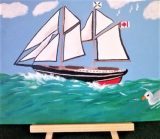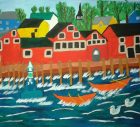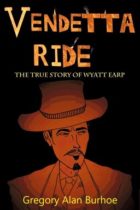A Tribute to George Marsh.
Author of the classic dog story FLASH THE LEAD DOG.
And…
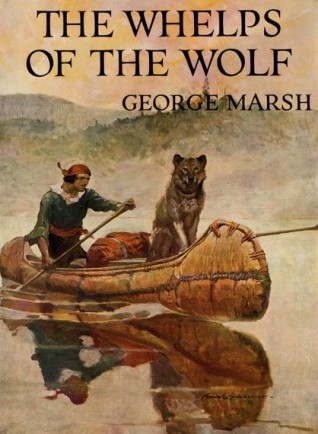
Wolf Whelps & Lead Dogs: Tribute to Wilderness Writer George Marsh
I must have been age nine when the kindly older couple next door gave me a copy of George Marsh’s THE WHELPS OF THE WOLF.
We had been back in Canada almost two years at that time. First, their dog Pal had befriended me. Pal followed me around after school and all of one golden summer, until we moved not too far away to the Golden Grove Road.
“Come in, Brian,” they would say. And in our talks, they discovered that I was enthralled by wilderness writers like Sir Charles G D Roberts, Jack London and Grey Owl, whose works I had found in the school library. I had asked for Grey Owl’s books for Christmas — it didn’t matter if they were used.
As word got around, that couple and others would give me old and faded (but treasured) books written by almost forgotten writers of Northern romantic adventures.
Writers like James Oliver Curwood, Ralph Conner, James B Hendryx, Gilbert Parker and H A Cody. They were pleased that a kid of the new generation revered their beloved writers of what to me seemed a long-ago and lost age. [1]
James O Curwood got mixed reviews from me. Even at a young age, I found some of his stories overly romanticized. But KAZAN THE WOLF DOG as well as THE GRIZZLY KING and NOMADS OF THE NORTH became lifetime faves.
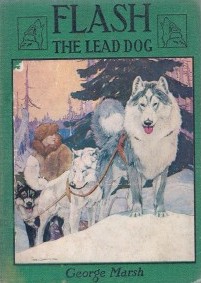 But of them all, it was three writers who enthralled me the most, taking me into the living heart of the mythic Northlands…
But of them all, it was three writers who enthralled me the most, taking me into the living heart of the mythic Northlands…
A Canadian raised in the Northwoods of my native New Brunswick. An Englishman who became a Red Indian who later charmed a young Princess Elizabeth. And an American who was an avid canoeist and Northcountry wanderer.
Charles G D Roberts, Archie Grey Owl and George Marsh. And, as savage as that land was, I wanted to live those adventures with them.
With George Marsh, first it was FLASH THE LEAD DOG, which I had read as a library lend (I now have my own copy). And then his THE WHELPS OF THE WOLF, a gift.
The hard covers of the latter book were a faded red and kind of loose, which just added to the sense of entering a lost Canadian age. This old book was a doorway into our nation’s past. The word WOLF promised a CALL OF THE WILD kind of yarn, and so it was.
As with all of his stories, George Marsh began WHELPS by taking me right into the Northcountry:
“The solitudes of the East Coast had shaken off the grip of the long snows. A thousand streams and rivers choked with snow water from bleak Ungava hills plunged and foamed and raced into the west. Seeking the salt Hudson’s Bay, the ‘Big Water’ of the Crees. In the lakes the honeycombed ice was daily fading under the strengthening sun. Already, here and there the buds of the willows reddened the river shores…”
And then he introduced our hero, making him a part of that country: “And one day, with the spring, Jean Marcel returned from his camp on the Ghost, the northernmost tributary of the Great Whale to the bald ridge. Where, in March, he had seen the sun glitter on a broad expanse of level snow unbroken by trees, in the hills to the north. His eyes had not deceived him. The lake was there.”
And that, my friend, was what endeared me to George Marsh.
His heroes are a bit bigger than life, yes, but somehow like us. I seemed to know these people. And they lived in a land of seasons, of waterways and woodlands. Of geese and ducks, and salmon and trout. Wolves, foxes, caribou, wolverines, lynxes, snow shoe rabbits and sleepy, hungry bears and wild, loyal wolf dogs. Marsh knew this land intimately.
It was the central character of his writings. Every living thing was connected, and the changing seasons affected everyone. Indeed, I’ve only found three writers since who could write as powerfully about the affect that nature’s seasons have on our human life and soul: Knut Hamsun, Henry Williamson and Farley Mowat.
Life and Works of Author George Marsh
George Tracy Marsh was born on August 9, 1876, in Lansingburgh, a town on the east bank of the Hudson River, New York State. His father was Pelatiah James Marsh. His mother was Lelia E Tracy. George had an older sister, Mary Ada Marsh, who was born six years before him.
He later said that growing up on the Hudson River had played an essential role in his development. “I lived most of my boyhood in canoe and shell, but slept and ate at home,” he explained in one interview. [2]
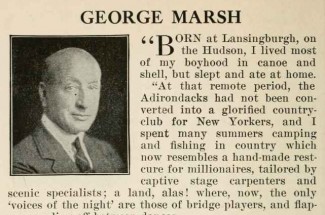
“At that remote period, the Adirondacks had not been converted into a glorified country club for New Yorkers. I spent many summers camping and fishing in country which now resembles a hand-made rest-cure for millionaires, tailored by captive stage carpenters and scenic specialists.
“A land, alas! where, now, the only ‘voices of the night’ are those of bridge players, and flappers cooling off between dances.”
His young adult life became one of canoeing and studying law. “Finishing at Williston, I went to Yale, where I was captain of the freshman crew, later going to Poughkeepsie and to the Henley Regatta with the varsity.
“Studying law at Harvard, I have since practiced in Providence. During the war, I served in the Infantry and the Air Service, and was detailed to attend the sittings of the Aeronautical Commission of the Peace Conference.” He refers, of course, to the First World War.
On September 30, 1915, he married Eva Corliss Weeden, who remained the love of his life. They lived in Providence, Rhode Island. They had one daughter, Carol (later, Mrs. John C. Develin of Philadelphia).
“Since the Adirondack days,” Marsh said, “I have hunted and fished in Canada, from western Labrador to Keewatin. Much of the background of my tales is familiar country — river valleys I have traveled, Hudson’s Bay posts whose hospitality I have known.”
In 1906, he traveled into the old growth pine forests and wild rivers of the Temagami and Temiskaming regions of Northern Ontario. The same region a young Englishman who would soon be named Grey Owl was also discovering.
This trip inspired some of Marsh’s early writing for magazines like Scribner’s (including his stirring ballad THE OLD CANOE in 1908) and Outing Magazine.
“In the summer of 1909 I went with a half-breed Cree to the headwaters of the great Albany River, a stream longer than the Ohio. We followed it 600 miles to Hudson’s Bay. We spent a month on the coast of the great salt bay of the north and saw the immense flights of geese and duck in September.”
As he wrote in an article titled “The Albany Trail To James Bay: Thirteen Hundred Miles By Canoe” (Scribner’s Magazine, April, 1912), “We had not run many rapids before we realized that our Maine canoes were unfitted for travelling on the great northern rivers. Although very light and easy-running, they were altogether too small for this kind of work. Invariably we shipped water in the ‘boilers’ at the foot of all big rapids…
“A hundred miles up this wild river, which races most of the time, we paddled, poled, and tracked to New Post.”
“There we found Mr. Sidney Barrett, the factor, the most genial and interesting of men. A day with Barrett and we pushed on past autumn woods in the thrall of the Indian Summer, picking up a young moose and racing with a bear on the way. There was snow in the air of the late October afternoon on which we paddled up to the crossing of the new Grand Trunk Pacific. And our days of hardship and delight in the silent places were ended.”
Out of this and similar trips through the wild Canadian Northlands, Marsh crafted his popular fiction.
Using his full name, he published some short pieces and poems in local magazines like The Forum (“Night In The Hospital,” October, 1909) and Short Stories (“The Baiting of Sampson,” Nov, 1909). In 1910, he changed the “Tracy” to a “T” and was publishing poems, short stories and articles in popular publications like The Outing Magazine (May 1910 “The Voyageurs”) and Scribner’s (May, 1916 “The Quest of Narcisse Lablanche”).
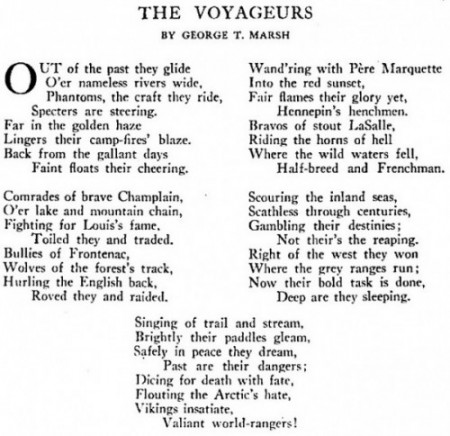
By the early 1920s, he had dropped the middle initial, publishing what would be his most popular works under the name of “George Marsh.”
He appeared in American magazines like Adventure Novels and Short Stories, The Popular Magazine, Short Stories, Complete Northwest Novel Magazine, Blue Book Magazine and Red Book Magazine. [3]
Marsh’s first published book was TOILERS OF THE TRAILS (1921), a collection of short stories. [4]
And then, in 1923, he published THE WHELPS OF THE WOLF.
This story of Jean Marcel was one of a young French Canadien voyageur finding his place in his world, and winning the love of Julie Breton. The story of Jean Marcel was also the story of an Ungava husky he buys as a pup and names Fleur. There’s a shortage of good sled dogs in the area and he knows he must build a superior dog team for a successful future. When Fleur is stolen, he ignores the advice of cooler heads and hunts down the thieves in a canoe chase, killing one of the thieves in self defense.
Later, when he and his hunting partners have run out of food far out in the wilderness (in what the Northern Cree call the Month of the Starving Moon), one of those partners threatens to slaughter Fleur and eat her. Jean leaves with his husky. This is a story of love and loyalty, and they save each other’s lives.
Only briefly does Fleur leave Jean, for a few days in April — and that is to mate with a wolf. “Fleur leave Jean Marcel for de wolf! Ah,” he realizes, “Eet ees de spreeng!” And the Ungava husky returns to him.
And the story ends, “…before repairing with their friends to the Mission House, where the groaning table awaited them, Julie and Jean Marcel, accompanied by Fleur, went to the stockade. Three gray noses thrust through the pickets whined a welcome. Three gigantic, wolfish huskies met them at the gate with wild yelps and the mad swishing of tails.
“Then the happy Jean and Julie gave the whelps of the wolf their share of the wedding feast.”
The book was a hit.
Marsh had blended archetypal Canadian characters like the proud, quick-tempered French Canadien voyageurs, wily Scottish factors, greedy Easterners, tough wilderness-wise First Nations people — along with the savage wolf dogs and wild rivers and forever forests — with his own experiences and discoveries of the Northcountry.
The success and popularity of WHELPS OF THE WOLF led to a demand for more Northwestern fiction from him. And for over two decades, Marsh responded.
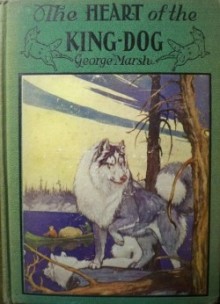 Jack London caught so powerfully the violence and tragedy of the North Country. And James Oliver Curwood, the romance and adventure. James B Hendryx, the exciting exploits of Mounties and outlaws. Grey Owl, the endangered living forests and the creatures that inhabited them. But it was George Marsh who caught the spirit of the Land itself — the forests and waterways, the wildlife, the people who were part of it all…
Jack London caught so powerfully the violence and tragedy of the North Country. And James Oliver Curwood, the romance and adventure. James B Hendryx, the exciting exploits of Mounties and outlaws. Grey Owl, the endangered living forests and the creatures that inhabited them. But it was George Marsh who caught the spirit of the Land itself — the forests and waterways, the wildlife, the people who were part of it all…
George Marsh died on August 13, 1945, four days after his 70th birthday, one day before VJ Day.
Dieu vous benisse, M’sieu le voyageur!
“But my days are done where the lean wolves run,
And I ripple no more the path
Where the gray geese race cross the red moon’s face
From the white wind’s Arctic wrath…”
==>> To read more by George Marsh, and hear a new rendition of his beloved ballad, go to THE OLD CANOE – A Classic Canadian Camp Song by George Marsh
==>> Want to run the thrilling whitewater of Frying Pan Rapids? Go to THE VALLEY OF VOICES – A North Woods Novel by George Marsh – Book Review
==>> Take off to the Great White North! SEE SLED TRAILS AND WHITE WATERS – A Collection of Stories by George Marsh – Book Review
==>> And be sure to read my popular online short story WOLFBLOOD, a Northwestern yarn in the Jack London and George Marsh Tradition at WOLFBLOOD: A Wild Wolf, A Half-Wild Husky, & A Wily Old Trapper
[1] These many years later, I’ve still got most of ’em. And continue to collect any old book set in our Great North Woods.
[2] BRIEF BIOGRAPHIES OF SOME WELL-KNOWN AUTHORS AND ILLUSTRATORS, by Samuel G Goodrich, page 60. Published by Penn Publishing Company, Philadelphia, 1929.
[3] Recently, THE WHELPS OF THE WOLF has been issued as an individual ebook (as of this writing, it’s available for free through Amazon Kindle) and a CreateSpace paperback, both editions wrongly attributed to “George P Marsh.”
George Perkins Marsh (1801-1882) was a different writer, considered to be America’s first major environmentalist. Following the lead of the traditional German conservative land owners fighting the destruction of the Black Forest by the new liberal Progressive industrialists, George Perkins Marsh identified Deforestation as a major danger to the living world. He pointed out that in parts of Asia, northern Africa, southern Europe and Palestine “causes set in action by Man has brought the face of the earth to a desolation almost as complete as that of the Moon.”
His books MAN AND NATURE (1864) and THE EARTH AS MODIFIED BY HUMAN ACTION (1874) greatly influenced later conservationists such as Teddy Roosevelt. And 150 years later, the man’s perception proves right on: Deforestation is a cause of modern Climate Change. Plant a tree. Plant a forest!
The editors of a new essential collection of his books titled WORKS OF GEORGE PERKINS MARSH (released by The Perfect Library in Kobo and Kindle editions in 2013) have also mistakenly added THE WHELPS OF THE WOLF to George Perkins’ canon.
But for all this, the CreateSpace paper edition cover gets George’s name right. A nice reprint worth getting. However, you may need to use “the whelps of the wolf, george P marsh” in the Amazon search box to find this edition.
[4] George Marsh’s published books are:
- Toilers of the Trails (1921)
- The Whelps of the Wolf (1923)
- The Valley of Voices (1924)
- Men Marooned (1925)
- Flash the Lead Dog (1927)
- Under Frozen Stars (1928)
- The Heart of the King-Dog (1929)
- Sled Trails and White Waters (1929)
- Three Little Ojibwas (1930)
- Vanished Men (1931)
- The River of Skulls (1936)
- White Silence (1938)
- Ask No Quarter (1945)
Some of his best short stories are:
Out of the Mist (The Century Magazine, April, 1917)
The Valley of the Windigo (Scribner’s Magazine, June, 1917)
Breed of the Wolf (The Popular Magazine, Jan 20, 1922)
McLeod’s Partner (Red Book Magazine, Jan, 1922)
The Honor of Hugh Garth (Short Stories, Nov 25, 1925)
A Question of Loyalty (The Popular Magazine, June 16, 1928)
Bent-Leg (The Popular Magazine, November 1, 1928)
The Knife That Burned (The Popular Magazine, June 1, 1929)
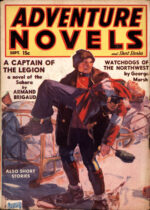 And later, in the Thirties…
And later, in the Thirties…
Vengeance of Black Fox (Red Book Magazine, Sept, 1935, reprinted)
The Twilight of André Girard (Complete Northwest Novel Magazine, Aug, 1936)
Ungava Gold (Blue Book Magazine, Nov, 1936)
Watchdogs of the Northwest (Adventure Novels and Short Stories, Sept, 1939 — Cover Story — George Marsh’s rare Canadian Mounties yarn)
George’s short masterpiece of Northwoods survival, “The Valley of the Windigo,” was reprinted in his TOILERS OF THE TRAILS, then in THE NORTHERNERS, Edited by Bill Pronzini and Martin H Greenberg.
 UPDATED Wednesday, Nov 15, 2023:
UPDATED Wednesday, Nov 15, 2023:
George Marsh’s classic first book is now available in a facsimile paperback edition from Amazon. It’s titled TOILERS OF THE TRAILS: Stories From the Great White North.
Featuring Frank Schoonover’s original cover art and inside illustrations.
An essential title for your Northwestern bookshelves.
2 COMMENTS:
[1] From Joshua D.
Brian,
I just happened to find this while looking for info on one of my family members. I happen to be George T. Marsh’s oldest great grandson and just began collecting old copies of his books. This article was an eye opener – I knew that he was a writer and that he had been fairly prolific, but I didn’t know how much he had affected people.
Fun family legend – my mother told me that MGM tried to turn Ask No Quarter into a movie, but my great grandmother turned them down, due to her (fairly accurate) opinion that Hollywood would butcher the material and was immoral in general. Given how they treated source material then, I would not be surprised if that would have happened as she feared it might.
After doing more research, I learned that the gentleman who created the illustrations for George’s books also did the same for Jack London. It is interesting that you brought up their similarities. By any chance, did they share a publishing company? That being said, thank you again for the write-up on George. I have already shared it with my mom, uncle, siblings, and cousin. This has made my day!
– Joshua D.
[2] From Brian Alan Burhoe
Hi Joshua
Thanks for your reply. Much appreciated.
My tribute to George Marsh was a labour of love and I tried to to do right by him.
I’m an aging Boomer, so the heyday of Northwestern fiction was over when I appeared on the scene. In the early Fifties, when I was discovering Charles G D Roberts, Grey Owl and Jack London, a number of older relatives (we’re a close-to-the-land but bookish people) and neighbours gave me some of the works of those earlier writers. And George Marsh remains a favourite.
It’s fun to re-read his work, not just because he was a natural storyteller, but because he KNEW the Northcountry. And the wildlife. And the people. Takes you there.
The artist you’re referring to is probably Charles Livingston Bull: https://www.civilizedbears.com/charles-livingston-bull-wildlife-artist/. He worked on the classic cover art for Jack London’s first edition of THE CALL OF THE WILD, published by Macmillan in 1903. Bull did some of the best cover art for George’s books, like FLASH THE LEAD DOG and THE HEART OF THE KING-DOG. Frank Earle Schoonover also did some great illustrations, including WHELPS OF THE WOLF. Schoonover seemed to thrive on thrilling whitewater canoe scenes.
To my knowledge, most of George’s books were first published by The Penn Publishing Company (of Philadelphia) or A L Burt Company (of New York). Grosset & Dunlap republished some of his most popular work, such as FLASH THE LEAD DOG.
Best wishes to you and yours,
– Brian
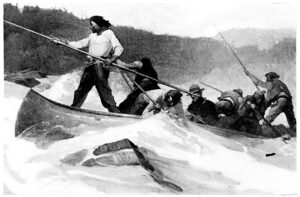
“Again at his signal the crew thrust the boat forward.” TOILERS OF THE TRAILS illustration by Frank Schoonover
Wolf Whelps & Lead Dogs: Tribute to George Marsh, Wilderness Writer
WANT TO READ MY STORIES, BOOK REVIEWS & ARTICLES ON YOUR MOBILE CELLPHONE OR TABLET? Go to my Mobile-Friendly BrianAlanBurhoe.com…
 WHITE SILENCE, released by The Penn Publishing Company in 1938, was George Marsh’s last Northern novel.
WHITE SILENCE, released by The Penn Publishing Company in 1938, was George Marsh’s last Northern novel.
He published one more book, a 17th Century Sea Story about a New England Privateer fighting the French in the West Indies.
Annotated bibliography, book list, book review, books, George Marsh bibliography, George Marsh Writer. Great Northwoods, Ungava Huskies, Western writer.




